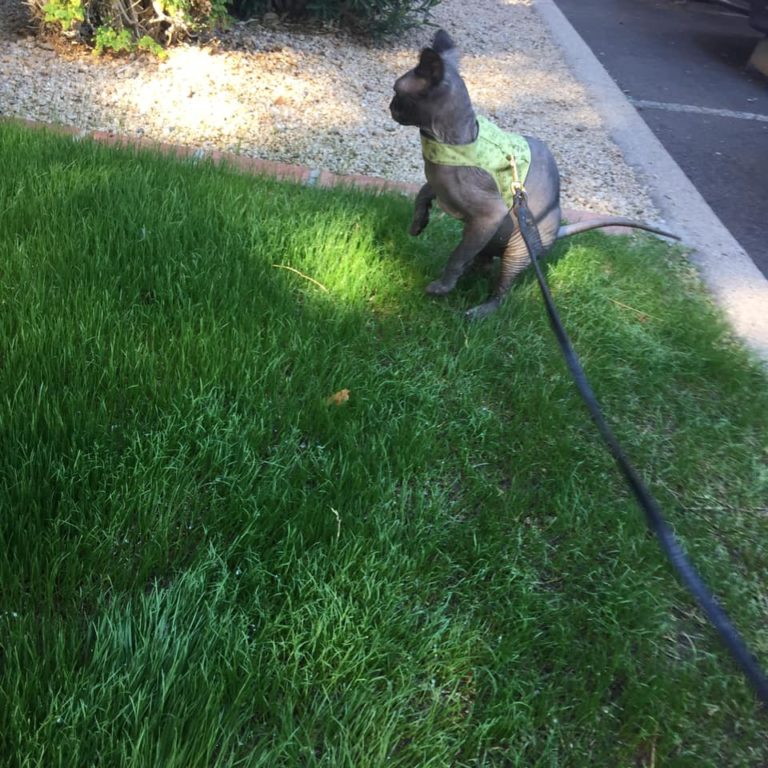
Cats have been in the news lately because a scientific study showed they probably do recognize their own names—but that doesn’t mean they’ll respond!
Cat lovers say, “Duh. That’s not news to us!”
Does your cat recognize its own name? Try this simple test and you may find out.
Does Your Cat Know Its Name? Here’s How To Find Out:
Cat lovers know that a cat may clearly indicate it recognizes its own name . . . but responding to that name (or any other word) in a way a human might want? That’s never a given with a cat.
Many people—some without cats, some with—believe that cats are not trainable. “Cats do what they do, cats are who they are, you can’t change their behavior . . . ”
I disagree.
Cats learn from experience what a particular sound predicts. The classic “can opener predicts cat food” is a prime example (more recent generations know the pull-tab noise, too). Cats learn that a quick response to that sound will be profitable.
Cats also learn that some sounds predict something negative, not safe, not rewarding. Cats learn how to respond to those “unsafe” sounds—run and hide!

Photo by Kea Grace
I asked cat owners what doesn’t work when teaching cats to come when called.
Jeanne Brennan (California) What doesn’t work? Standing there holding a door open expectantly. Leave it open and walk away . . . seems they cross the threshold every time.
Julie Ellingson (California) Just like puppies—calling them to do something unpleasant (like nails) is very effective for teaching them not to come when called.
Amy Suggars (Ohio) Saying “treat” doesn’t work, either!!
Lorna Doone Brewer (Washington) Really, really wanting them to come.
Meira Frankl (Quebec) Hollering at them doesn’t really seem to work that well.
Rebecca Cook (Washington) I find it is entirely dependent on their mood, but if I call in an angry tone, there is no way they will come.
Jules Weber (Maryland) My one cat isn’t a fan of being picked up or cuddled. He’s more of a “MURDER! EVERYTHING! MUST! DIE!” sort of kitty. (We are completely safe from dust bunnies and the invisible monsters in the carpet.) So if I call him and pick him up, he thinks I just pooped in his cornflakes. My other cat is the opposite—if I call him and don’t pick him up, he will pout and try to climb me to be held.
Cat lovers agreed—often, they had not intentionally set out to teach cats their own names, or to train cats to come when they were called. The cats seemed to have taught themselves, probably by responding profitably to “predictors” in their environments.
Christine Smith (Australia) Our cats were all strays—they come to the sound of food of any kind being prepared! However, there are occasions when they don’t come. I would say it’s about 95% reliable. Usually when they don’t come, it seems to be just that they don’t want to, rather than more complex reasons. I had trained one from kittenhood to a “tsking” sound I made, but have not had success with others doing this. With that cat, I made the noise whenever I fed her, and eventually she would (generally) come when I made the noise to call her. They all seem to know their names, and will respond by looking at me and sometimes coming to their names. One of them seems to know all the names, and comes [regardless of] whomever is called . . . in the hope of getting extra treats, I suspect, as he is a greedy boy.
Marie Hammerling (Florida) My cats taught themselves their own names. I had one cat, Louie. (Actually, his name was Luis, but he would not answer to Luis. He only answered to Lulu or Louie.) Our three current cats all learned their names on their own. I got them when they were already six months old or a bit older, so they had previous names. However, they had no problem responding to their new names.
Alison Taub (California) My cat taught himself. I was very surprised when I realized he even knew his name, and more so when I realized he was responding to it. I didn’t call him much, but I did feed him and I guess he focused on my voice.
Megan Wilson (Tasmania) I didn’t [teach my cat to come when called]. She naturally has a better recall than my dogs.

Photo by Kea Grace
Would you like to teach your cat to respond to its name, or to come when you call?
Choose rewards. What does your cat really like?
▪ Food Meals or special treats
▪ Toys Interactive may be best
▪ Access To catio, other valued spot
▪ Attention Petting, playing, fun
Katey Aldred (England) Building lots and lots of positive experiences, provided by me, associated with their names. I also clicker-trained one of the cats.
Nathalie Mosbach Smith (California) Just like training a dog. Rewards are boiled chicken, turkey sandwich meat, or tuna—something they usually don’t get. I don’t use “come.” I call their names. Also, I feed the good stuff for dinner and kibble is accessible at all times.
Ann Marie Danimus (Washington) Pounce [cat treats]. She now recognizes the words “chicken cookies” . . . but if she doesn’t want to come, she ain’t coming!
Kim Campbell Thornton (California) We whistled as we set down their food bowls and very quickly they learned to come to a whistle. Then future cats learned from the original cats to come to a whistle.
Katt Patt (Washington) I have not had an issue with “Here, kitty, kitty” on all my cats. For some reason, my British Shorthair will come to you if you say his name and just talk to him. Maybe they come because you call them only to give them love or food.
Peggy Modjeski (Kentucky) My cat [was] in a litter of three. I got them at about three weeks. They were raised by my senior chihuahua mix. The kitten my dog bonded with stayed with us. He is very “dog-like.” He does basic obedience like sit, down, stay, come, as well as tricks like shake, sit up, roll over. He learned by observing my dog and wanting in on the action. I train my dogs with positive reinforcement and I accidentally trained my cat! He even sleeps in a crate—his choice because the door is open. I use Origen freeze-dried dog treats.
Could your cat ever be as well-trained as a dog? I don’t see why not, if the cat’s health and temperament allow. Look online for videos of cats who’ve been positively trained to do tricks—even to perform in cat circuses!
Your cat may not jump through hoops (although why not?), but you can have fun and build your relationship with any positive training that you do.
It’s up to you to practice often, set up for success, and enjoy the process.
▪ Start with basic behaviors like name recognition and coming when called.
▪ Add in moves your cat performs naturally, like reaching with a paw, to teach a trick or tricks that involve the move.
▪ Get those tricks on cue!
▪ Introduce targeting behavior in which the cat touches with nose or paw an object or your hand, with the goal of directing the cat to move to that target and interact with it.
Indoor-only cats can be safely trained outside to do recalls (coming when called) in harnesses and on long lines, but of course you must first allow the cat as much time and patience as necessary to accept and to enjoy wearing the harness and going outside on a leash.
Even cats who never go outside could benefit from recall training (inside) should they ever escape or be let out accidentally. Your cat could be saved from a very unsafe experience because you took the time to train a recall!



